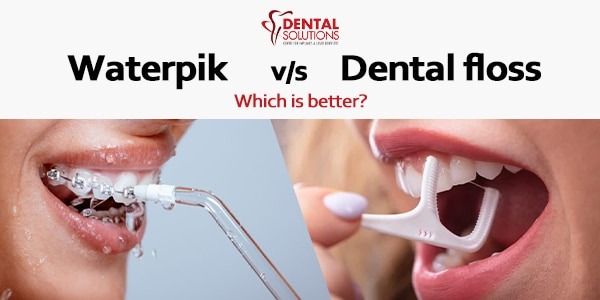Waterpik or String Flossing: Which is best?

Waterpiks are oral irrigating devices that help clean your teeth with a stream of water instead of a strand of floss which is a traditional flossing technique.
If you visit your dentist, probably your dentist would have asked you “Are you flossing regularly?” It's asked so because it is important! Most of us hate running a piece of floss in between the teeth and hence leave flossing out of our daily oral cleaning routine. But do you think just brushing your teeth is sufficient to ensure plaque removal and prevention of cavities?
Interdental cleaning, such as flossing, is essential for maintaining good oral health. There are two options for interdental cleaning: Thread flossing and Waterpik—
When it comes to comparing thread flossing vs Waterpik, you might be in for a pleasant surprise! Because there are some big benefits to consider—
Thread Flossing Method:

Flossing must be ideally done every day. For it to work, you must wrap the string dental floss against your tooth in a “C” shaped manner and then rub it up and down the side and under the gums.
But, thread flossing can only reach about 1-3mm into your gum pockets. In case, if you have gum disease with periodontal pockets deeper than 4mm, regular floss can't help you clean the gums. Thread flossing can't clean the concavities on the sides of your tooth roots. When you use thread flossing, you can just clean between teeth and under the edges of your gums.
It is not easy to reach deeper than 3-4mm into your periodontal pockets with thread floss. This can be a problem if you have periodontal disease or gum disease.
Waterpik Flossing Method:

Oral irrigating devices are special devices that you can use in addition to traditional flossing to reach down into deeper periodontal pockets which are not likely possible with thread flossing alone.
Technically, replacing regular flossing with water flossing or Waterpik is not advisable, but some people benefit more from using a Waterpik compared to thread floss. Apart from keeping away the plaque on teeth using Waterpik also ensure healthy gums, and reduces bleeding. In addition, the steady stream of water spray on the teeth and gums ensures stimulation of gums ultimately leading to better blood circulation.
Who should use Waterpik flossing?
Anybody can use a water flosser. In fact, it is a whole lot easier than dental floss if you're cleaning around things like:
- Braces
- Orthodontic appliances and retainers
- Dental implants
- Dental bridges
The ultimate goal of using a Waterpik is to prevent periodontal infections by keeping gums healthy. Water flossing does not prevent cavities but can help prevent gum disease and fight against inflamed gums. Some benefit from it more than others do.
This is a most asked question: Is water flossing better than traditional string floss? Research also says water flossing can clean deep inside the gum pockets in patients with periodontal disease.
Although water flosser is an “additional” tool you use along with traditional flossing, some people that use them find they don't need string floss at all, which is not true!
Research repeatedly suggests that using a water flosser is superior to conventional thread flossing.
Here are a few reasons to choose Waterpik over thread flosser:
- Cleans around braces, and implants
- Easy to reach around the braces
- Reaches deep under the gums to clean periodontal pockets
- Works in pockets up to 7+mm for people with dexterity issues
Waterpik is best for Gum Disease Prevention
Gum disease or periodontitis is an inflammatory response to plaque bacteria next to your gum tissues. You need to clean the plaque build-up away every day to avoid the spread of infection. Using Waterpik is one of the best ways to flush the biofilm away from gums and out from under gum pockets.
Using water lavage effectively reduces bleeding gums, keeps your gums healthy.
Since your toothbrush or traditional floss can't reach deep under the gums, adding a water flosser to your routine will flush away any loose bacteria.
Hence, switching to a water flosser is scientifically proven to be a better option for cleaning away plaque biofilm than thread flossing.
What more reasons are needed to finally take the leap? Discuss with the dentist for more information. Find a dentist near your location!

Dr Balu,
That is a very interesting write up.
It clarifies many doubts . After going thru a gum issue myself and after treatment by you, I am trying to spread awareness of gum care and how inadequate just brushing twice a day is . Water flossing is the real cleaning!